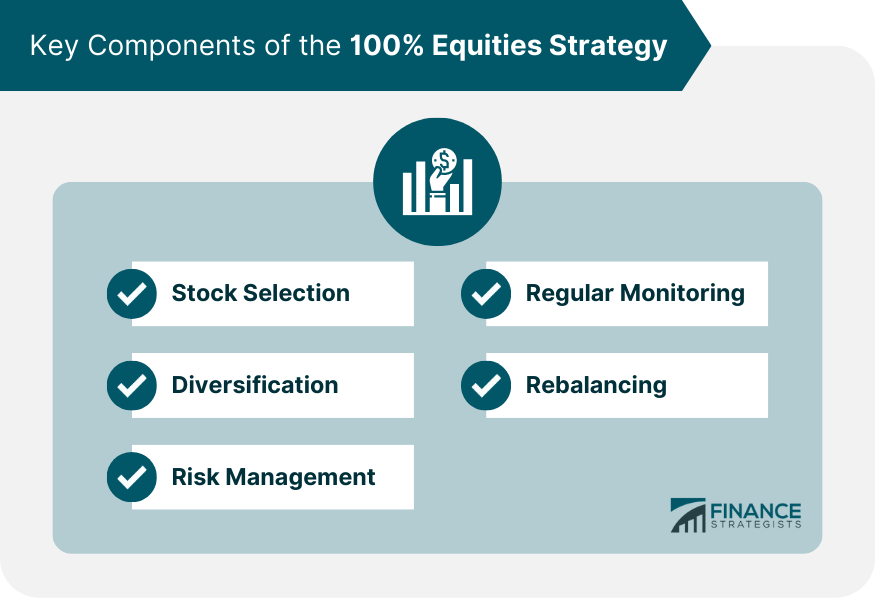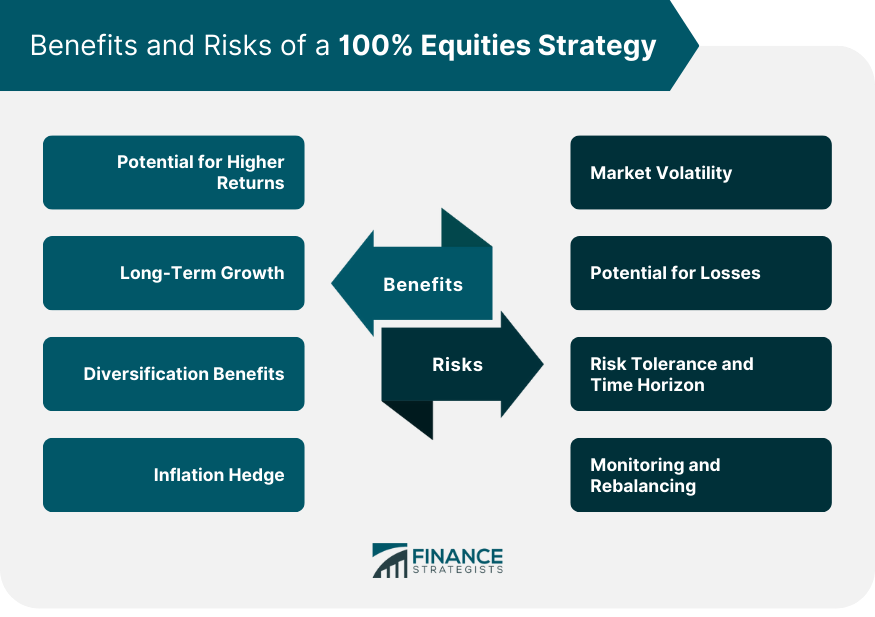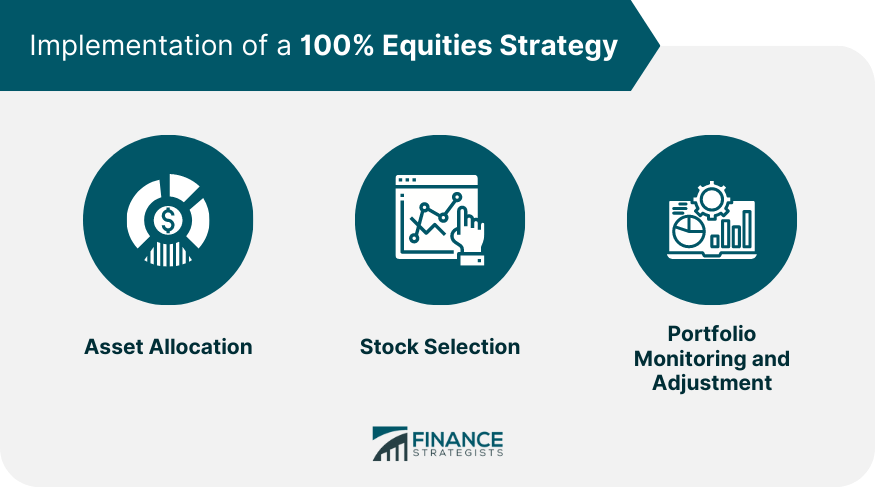The 100% Equities Strategy, also referred to as an all-equity portfolio, is an investment approach that involves allocating the entirety of an investor's portfolio to stocks or equities. In this strategy, there are no allocations to other asset classes like bonds, cash, or real estate. The main objective of the 100% Equities Strategy is to capitalize on the potential of equity investments to achieve long-term capital appreciation. By investing solely in stocks, investors aim to benefit from the historically higher returns that equities have offered compared to other asset classes over the long term. Equities have the potential for capital growth through price appreciation and dividends. This strategy is often pursued by investors who have a higher risk tolerance and a longer investment horizon, as stocks can be more volatile in the short term. The heart of the 100% Equities Strategy lies in selecting the right stocks to include in the portfolio. Investors need to conduct thorough research, analyze company fundamentals, assess growth prospects, and consider various valuation metrics to identify high-quality stocks that align with their investment goals. Despite the portfolio consisting solely of stocks, diversification plays a vital role in managing risk. Investors should diversify across different sectors, industries, and geographic regions to reduce the impact of any individual stock's performance on the overall portfolio. Investing solely in equities carries inherent risks, such as market volatility and potential losses. Therefore, risk management becomes crucial in the 100% Equities Strategy. Investors must assess their risk tolerance, set realistic expectations, and consider their investment time horizon to ensure they can withstand market fluctuations. Continuous monitoring of the portfolio is essential in the 100% Equities Strategy. Investors should stay updated with company news, industry trends, and macroeconomic factors that can influence stock prices. Regular portfolio review allows investors to make informed decisions and take timely action if needed. Periodic rebalancing is necessary to maintain the desired allocation within the 100% Equities Strategy. As stock prices fluctuate, the portfolio's composition may deviate from the intended allocation. Rebalancing involves selling stocks that have performed well and buying those that have underperformed to bring the portfolio back in line with the desired asset allocation. By understanding the definition and key components of the 100% Equities Strategy, investors can gain insights into how this strategy operates and what considerations they need to keep in mind when implementing it. One of the primary advantages of the 100% Equities Strategy is its potential for higher returns compared to other investment strategies. Historically, equities have outperformed other asset classes over the long term. By allocating the entire portfolio to stocks, investors can participate in the growth potential of well-performing companies and benefit from capital appreciation. Stocks have the potential to deliver substantial returns, especially in dynamic and growing sectors. Companies that exhibit strong earnings growth, innovative business models, and competitive advantages can generate significant shareholder value over time. The 100% Equities Strategy is well-suited for investors with a long-term investment horizon. By focusing on equities, which have historically exhibited long-term growth trends, investors can benefit from the compounding effect over extended periods. This strategy allows investors to ride out short-term market fluctuations and capture the potential rewards associated with sustained growth. Equity investments provide an opportunity to participate in a company's success as it expands its market share, launches new products, or enters new markets. Contrary to the notion that the 100% Equities Strategy lacks diversification, it actually offers diversification benefits within the stock market itself. By selecting stocks from various sectors and industries, investors can build a diversified portfolio that mitigates the risks associated with specific companies or sectors. Furthermore, the global nature of equity markets provides opportunities for geographic diversification. Investors can invest in stocks across different countries and regions, thereby reducing their exposure to any single market or economy. Equities have historically served as an effective hedge against inflation. Unlike fixed-income investments, such as bonds, which may lose purchasing power during periods of inflation, equities have the potential to generate higher returns that outpace inflation. Inflation erodes the value of cash and fixed-income securities over time. However, companies with pricing power can adjust their product prices to keep pace with inflation, thereby preserving and growing their earnings. By investing in a 100% Equities Strategy, investors can potentially benefit from companies' ability to maintain their purchasing power and generate real returns even in inflationary environments. Equity markets are known for their inherent price fluctuations, driven by various factors such as economic conditions, geopolitical events, and investor sentiment. During periods of market volatility, stock prices can experience significant ups and downs, which can impact the value of a portfolio. Stock prices can decline due to various reasons, including poor company performance, industry disruptions, or adverse market conditions. Investors must be aware of the risk of capital loss and be prepared for the possibility of a decline in the value of their investments. To manage this risk, investors should conduct thorough research and due diligence before selecting individual stocks. The 100% Equities Strategy is most suitable for investors with a higher risk tolerance and a longer investment time horizon. Investors should assess their risk tolerance by considering factors such as their financial goals, investment experience, and ability to handle potential losses. This strategy is better suited for long-term investors who can withstand short-term market volatility and have the flexibility to ride out any downturns. Regular monitoring and portfolio rebalancing are essential considerations when implementing a 100% Equities Strategy. Market conditions and individual stock performances can cause the allocation within the portfolio to deviate from the desired asset allocation. Investors need to actively monitor their portfolio and periodically rebalance it to maintain the desired allocation. This involves selling stocks that have appreciated significantly and buying stocks in sectors or regions that may be underrepresented. Asset allocation involves determining the ideal distribution of investment capital across different equity assets. The goal is to create a diversified portfolio that balances risk and return potential. When allocating assets, investors need to consider factors such as their risk tolerance, investment goals, and time horizon. They can allocate their capital among various equity categories, including domestic and international stocks, large-cap and small-cap stocks, and different industry sectors. Stock selection is another critical aspect of implementing a 100% Equities Strategy. It involves identifying individual stocks to include in the portfolio. Investors should conduct thorough research and analysis to select stocks that have the potential for long-term growth and align with their investment goals. Investors can consider various factors when selecting stocks, such as company fundamentals, financial performance, competitive advantage, industry trends, and valuation metrics. They can also utilize fundamental analysis, technical analysis, and other investment strategies to identify stocks that offer attractive growth prospects. Effective portfolio monitoring and adjustment are critical for the success of a 100% Equities Strategy. Investors should regularly review their portfolio's performance and make necessary adjustments to ensure it remains aligned with their investment objectives. Monitoring the portfolio involves tracking the performance of individual stocks, analyzing sector and market trends, and assessing the overall portfolio's risk and return characteristics. This can be done through the use of portfolio management tools, financial analysis software, and regular portfolio reviews. Based on the monitoring results, investors may need to make adjustments to their portfolio. This could involve selling underperforming stocks, rebalancing the portfolio to maintain the desired asset allocation, or adding new stocks that align with the investment strategy. The main difference between a 100% Equities Strategy and a balanced portfolio is the level of risk and potential return. A 100% Equities Strategy, as the name suggests, focuses solely on equities, which tend to have higher volatility. This strategy offers the potential for higher returns over the long term but also comes with increased risk. On the other hand, a balanced portfolio aims to mitigate risk by diversifying across asset classes. By including fixed income assets, it provides stability and acts as a cushion during market downturns. While a balanced portfolio may offer lower potential returns compared to a 100% Equities Strategy, it provides a more conservative approach with reduced volatility. A 100% Equities Strategy is geared towards capital appreciation and long-term growth. Equities have historically provided higher returns compared to bonds and fixed income investments. However, equities are subject to market volatility and carry a higher level of risk. On the other hand, bonds and fixed income investments offer stability and a regular income stream through interest payments. They are considered less risky than equities and provide a way to preserve capital. However, the returns from bonds and fixed income investments are generally lower than those from equities, especially during periods of low interest rates. Investors who prioritize capital preservation and a steady income stream may prefer a strategy focused on bonds and fixed income. Conversely, those willing to accept higher risk for the potential of greater returns may opt for a 100% Equities Strategy. A 100% Equities Strategy concentrates solely on equities, potentially offering higher returns but exposing the portfolio to greater market volatility. In contrast, a diversified investment mix combines different asset classes, such as equities, bonds, real estate, and alternative investments, to spread risk and potentially enhance returns. By diversifying across asset classes, investors aim to create a portfolio that balances risk and return, potentially smoothing out volatility over time. However, it's important to note that a 100% Equities Strategy may outperform a diversified investment mix during periods of strong equity market performance. The 100% Equities Strategy, or all-equity portfolio, involves exclusively investing in stocks to leverage their historically higher returns for long-term capital appreciation. The strategy's key components include meticulous stock selection, diversification, rigorous risk management, ongoing monitoring, and periodic rebalancing. This strategy provides the potential for higher returns, long-term growth, diversification within the stock market, and an inflation hedge. However, it also carries risks such as market volatility and potential losses, necessitating a high risk tolerance and a longer investment horizon. Regular monitoring and rebalancing of the portfolio are also essential to mitigate these risks. When adopting a 100% Equities Strategy, investors must consider asset allocation across different equity classes, choose high-quality stocks based on comprehensive research, and routinely adjust their portfolio in line with their investment goals.Definition of 100% Equities Strategy
Key Components of the 100% Equities Strategy
Stock Selection
Diversification
Risk Management
Regular Monitoring
Rebalancing

Benefits of a 100% Equities Strategy
Potential for Higher Returns
Long-Term Growth
Diversification Benefits
Inflation Hedge
Risks and Considerations
Market Volatility
Potential for Losses
Risk Tolerance and Time Horizon
Monitoring and Rebalancing

Implementation of a 100% Equities Strategy
Asset Allocation
Stock Selection
Portfolio Monitoring and Adjustment

Comparison With Other Investment Strategies
100% Equities vs Balanced Portfolio
100% Equities vs Bonds and Fixed Income
100% Equities vs Diversified Investment Mix
Final Thoughts
100% Equities Strategy FAQs
A 100% Equities Strategy refers to an investment approach where the entire portfolio is allocated to stocks or equities, with no allocation to other asset classes like bonds or cash.
A 100% Equities Strategy offers the potential for higher returns, long-term growth, diversification benefits, and acts as an inflation hedge.
Yes, there are risks involved. Market volatility can impact equity prices, and there is a potential for losses. Investors need to consider their risk tolerance and time horizon before adopting this strategy.
Implementing a 100% Equities Strategy involves determining asset allocation, selecting individual stocks, and regularly monitoring and adjusting the portfolio to maintain the desired allocation.
A 100% Equities Strategy can be compared to balanced portfolios, bond and fixed income strategies, and diversified investment mixes. Each strategy has its own risk-return profile, and the choice depends on an investor's goals and risk tolerance.
True Tamplin is a published author, public speaker, CEO of UpDigital, and founder of Finance Strategists.
True is a Certified Educator in Personal Finance (CEPF®), author of The Handy Financial Ratios Guide, a member of the Society for Advancing Business Editing and Writing, contributes to his financial education site, Finance Strategists, and has spoken to various financial communities such as the CFA Institute, as well as university students like his Alma mater, Biola University, where he received a bachelor of science in business and data analytics.
To learn more about True, visit his personal website or view his author profiles on Amazon, Nasdaq and Forbes.











